Deck 8: The Skeletal System: the Appendicular Skeleton
Question
Question
Question
Question
Question
Question
Question
Question
Question
Question
Question
Question
Question
Question
Question
Question
Question
Question
Question
Question
Question
Question
Question
Question
Question
Question
Question
Question
Question
Question
Question
Question
Question
Question
Question
Question
Question
Question
Question
Question
Question
Question
Question
Question
Question
Question
Question
Question
Question
Question
Question
Question
Question
Question
Question
Question
Question
Question
Question
Question
Question
Question
Question
Question
Question
Question
Question
Question
Question
Question
Question
Question
Question
Question
Question

Unlock Deck
Sign up to unlock the cards in this deck!
Unlock Deck
Unlock Deck
1/75
Play
Full screen (f)
Deck 8: The Skeletal System: the Appendicular Skeleton
1
The patellar surface, with which the patella articulates, is located on the _____ end of the _____.
A) proximal, tibia
B) distal, tibia
C) proximal, femur
D) distal, femur
A) proximal, tibia
B) distal, tibia
C) proximal, femur
D) distal, femur
D
2
Using the following directional terms, decide which bone is being described: medial to metatarsal III; proximal to proximal phalanx; distal to second (intermediate) cuneiform.
A) cuboid
B) lateral cuneiform
C) metatarsal II
D) metatarsal IV
A) cuboid
B) lateral cuneiform
C) metatarsal II
D) metatarsal IV
C
3
Which of the following is an articular feature of the tibia?
A) tibial tuberosity
B) anterior border
C) lateral condyle
D) none of these choices
A) tibial tuberosity
B) anterior border
C) lateral condyle
D) none of these choices
C
4
The ulna:
A) has a radial notch on its lateral surface.
B) has a radial notch on its medial surface.
C) articulates with the metacarpals.
D) has an olecranon fossa on the anterior surface.
A) has a radial notch on its lateral surface.
B) has a radial notch on its medial surface.
C) articulates with the metacarpals.
D) has an olecranon fossa on the anterior surface.

Unlock Deck
Unlock for access to all 75 flashcards in this deck.
Unlock Deck
k this deck
5
The cup-shaped depression formed by all three portions of the hip (coxal) bone is the _____.
A) false pelvis
B) obturator foramen
C) acetabulum
D) glenoid cavity
A) false pelvis
B) obturator foramen
C) acetabulum
D) glenoid cavity

Unlock Deck
Unlock for access to all 75 flashcards in this deck.
Unlock Deck
k this deck
6
Which of the following is found on the anterior surface of the humerus?
A) deltoid tuberosity
B) radial fossa
C) greater tubercle
D) medial epicondyle
A) deltoid tuberosity
B) radial fossa
C) greater tubercle
D) medial epicondyle

Unlock Deck
Unlock for access to all 75 flashcards in this deck.
Unlock Deck
k this deck
7
Which of the following is not part of the ilium?
A) greater sciatic notch
B) inferior gluteal line
C) lesser sciatic notch
D) auricular surface
A) greater sciatic notch
B) inferior gluteal line
C) lesser sciatic notch
D) auricular surface

Unlock Deck
Unlock for access to all 75 flashcards in this deck.
Unlock Deck
k this deck
8
Which of these does not belong to the distal row of carpal bones?
A) pisiform
B) trapezoid
C) trapezium
D) capitate
A) pisiform
B) trapezoid
C) trapezium
D) capitate

Unlock Deck
Unlock for access to all 75 flashcards in this deck.
Unlock Deck
k this deck
9
The number of phalanges in one hand is
A) 5
B) 10
C) 14
D) 15
A) 5
B) 10
C) 14
D) 15

Unlock Deck
Unlock for access to all 75 flashcards in this deck.
Unlock Deck
k this deck
10
The bony landmarks commonly referred to as "knuckles" are the
A) bases of proximal phalanges.
B) heads of proximal phalanges.
C) bases of metacarpals.
D) heads of metacarpals.
A) bases of proximal phalanges.
B) heads of proximal phalanges.
C) bases of metacarpals.
D) heads of metacarpals.

Unlock Deck
Unlock for access to all 75 flashcards in this deck.
Unlock Deck
k this deck
11
Which of the following is not a tarsal bone?
A) navicular
B) hamate
C) cuboid
D) cuneiform
A) navicular
B) hamate
C) cuboid
D) cuneiform

Unlock Deck
Unlock for access to all 75 flashcards in this deck.
Unlock Deck
k this deck
12
The clavicle
A) articulates with the acromion and the manubrium.
B) is convex anteriorly in the lateral half.
C) is flatter near the medial end.
D) is anterior to the ribs.
A) articulates with the acromion and the manubrium.
B) is convex anteriorly in the lateral half.
C) is flatter near the medial end.
D) is anterior to the ribs.

Unlock Deck
Unlock for access to all 75 flashcards in this deck.
Unlock Deck
k this deck
13
Which of the following is true of the radius?
A) It is the medial bone of the forearm.
B) Its head articulates with the distal end of the ulna.
C) It articulates with the trochlear notch of the humerus.
D) none of these choices
A) It is the medial bone of the forearm.
B) Its head articulates with the distal end of the ulna.
C) It articulates with the trochlear notch of the humerus.
D) none of these choices

Unlock Deck
Unlock for access to all 75 flashcards in this deck.
Unlock Deck
k this deck
14
The male skeleton, as compared to the female skeleton,
A) has heavier bones.
B) has rougher, larger tuberosities and ridges.
C) has a heart-shaped pelvic inlet.
D) All of the choices are correct.
A) has heavier bones.
B) has rougher, larger tuberosities and ridges.
C) has a heart-shaped pelvic inlet.
D) All of the choices are correct.

Unlock Deck
Unlock for access to all 75 flashcards in this deck.
Unlock Deck
k this deck
15
Using the following directional terms, decide which structure of the scapula is being described: lateral to the spine; inferior to the acromion; posterior to the coracoid process; proximal to the head of the humerus.
A) inferior angle
B) glenoid cavity
C) supraspinous fossa
D) acetabulum
A) inferior angle
B) glenoid cavity
C) supraspinous fossa
D) acetabulum

Unlock Deck
Unlock for access to all 75 flashcards in this deck.
Unlock Deck
k this deck
16
Using the following directional terms, decide which bone is being described: proximal to metacarpal I; distal to the scaphoid bone; and lateral to the trapezoid bone.
A) trapezium
B) capitate
C) hamate
D) proximal phalanx
A) trapezium
B) capitate
C) hamate
D) proximal phalanx

Unlock Deck
Unlock for access to all 75 flashcards in this deck.
Unlock Deck
k this deck
17
Which of the following is true?
A) The medial end of the clavicle is the sternal extremity.
B) The curvature of the medial one-third of the clavicle is concave anteriorly.
C) The clavicle articulates medially with the body of the sternum and laterally with the acromion of the scapula.
D) All of these statements are true.
A) The medial end of the clavicle is the sternal extremity.
B) The curvature of the medial one-third of the clavicle is concave anteriorly.
C) The clavicle articulates medially with the body of the sternum and laterally with the acromion of the scapula.
D) All of these statements are true.

Unlock Deck
Unlock for access to all 75 flashcards in this deck.
Unlock Deck
k this deck
18
Using the following directional terms, decide which structure of the pelvis is being described: medial to the ischium; inferior to the ilium; lateral to the pubic symphysis; medial to the acetabulum.
A) pubis
B) lesser sciatic notch
C) auricular surface
D) lesser trochanter
A) pubis
B) lesser sciatic notch
C) auricular surface
D) lesser trochanter

Unlock Deck
Unlock for access to all 75 flashcards in this deck.
Unlock Deck
k this deck
19
The scapula
A) has three large nonarticular fossae that occupy a large portion of the surface of the bone.
B) articulates with the thoracic region of vertebral column.
C) articulates with the acromion and the manubrium.
D) is anterior to the ribs.
A) has three large nonarticular fossae that occupy a large portion of the surface of the bone.
B) articulates with the thoracic region of vertebral column.
C) articulates with the acromion and the manubrium.
D) is anterior to the ribs.

Unlock Deck
Unlock for access to all 75 flashcards in this deck.
Unlock Deck
k this deck
20
The coracoid process of the scapula is
A) a site of muscle attachment.
B) an extension of the scapular spine.
C) the high point of the shoulder.
D) All of the choices are correct.
A) a site of muscle attachment.
B) an extension of the scapular spine.
C) the high point of the shoulder.
D) All of the choices are correct.

Unlock Deck
Unlock for access to all 75 flashcards in this deck.
Unlock Deck
k this deck
21
The heads of the metacarpals form the "knuckles" of the fist.

Unlock Deck
Unlock for access to all 75 flashcards in this deck.
Unlock Deck
k this deck
22
List the bones that make up the appendicular skeleton using the headings pectoral girdles, free part of the upper extremity, pelvic girdle, free part of the lower extremity.

Unlock Deck
Unlock for access to all 75 flashcards in this deck.
Unlock Deck
k this deck
23
The arcuate line of the ilium is continuous with the pectineal line of the pubis.

Unlock Deck
Unlock for access to all 75 flashcards in this deck.
Unlock Deck
k this deck
24
The false (greater) pelvis is superior to the pelvic brim.

Unlock Deck
Unlock for access to all 75 flashcards in this deck.
Unlock Deck
k this deck
25
The posterior inferior portion of the hip (coxal) bone is the pubis.

Unlock Deck
Unlock for access to all 75 flashcards in this deck.
Unlock Deck
k this deck
26
This is an ______ view of the _____. 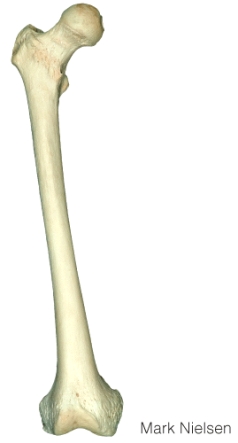
A) anterior; tibia
B) posterior; tibia
C) anterior; femur
D) posterior; femur

A) anterior; tibia
B) posterior; tibia
C) anterior; femur
D) posterior; femur

Unlock Deck
Unlock for access to all 75 flashcards in this deck.
Unlock Deck
k this deck
27
Visible in this view of the femur is/are the 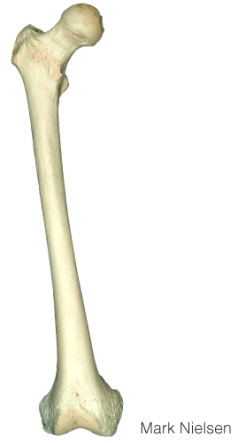
A) greater and lesser trochanters near the proximal end
B) intercondylar fossa at the proximal end
C) linea aspera
D) Acetabulum

A) greater and lesser trochanters near the proximal end
B) intercondylar fossa at the proximal end
C) linea aspera
D) Acetabulum

Unlock Deck
Unlock for access to all 75 flashcards in this deck.
Unlock Deck
k this deck
28
The raised roughened area, just distal to the neck of the radius, that serves as a point of attachment for the tendon of the biceps brachii muscle is the biceps tuberosity.

Unlock Deck
Unlock for access to all 75 flashcards in this deck.
Unlock Deck
k this deck
29
The fibula, the lateral bone of the leg, is a weight-bearing bone.

Unlock Deck
Unlock for access to all 75 flashcards in this deck.
Unlock Deck
k this deck
30
The patella has an/is
A) intercondylar fossa at the proximal end.
B) completely enclosed in a tendon.
C) intercondylar eminence at the distal end.
D) acetabulum.
A) intercondylar fossa at the proximal end.
B) completely enclosed in a tendon.
C) intercondylar eminence at the distal end.
D) acetabulum.

Unlock Deck
Unlock for access to all 75 flashcards in this deck.
Unlock Deck
k this deck
31
The head of the ulna is on the distal end of the bone.

Unlock Deck
Unlock for access to all 75 flashcards in this deck.
Unlock Deck
k this deck
32
The capitulum of the humerus is lateral to the trochlea.

Unlock Deck
Unlock for access to all 75 flashcards in this deck.
Unlock Deck
k this deck
33
The coracoid process of the scapula may be described as a lateral extension of the spine of the scapula.

Unlock Deck
Unlock for access to all 75 flashcards in this deck.
Unlock Deck
k this deck
34
The olecranon, which forms the prominence of the elbow, is located on the distal end of the humerus.

Unlock Deck
Unlock for access to all 75 flashcards in this deck.
Unlock Deck
k this deck
35
The tibia
A) has a medial malleolus at the distal end.
B) is the lateral bone of the leg.
C) has a head.
D) has an intercondylar fossa.
A) has a medial malleolus at the distal end.
B) is the lateral bone of the leg.
C) has a head.
D) has an intercondylar fossa.

Unlock Deck
Unlock for access to all 75 flashcards in this deck.
Unlock Deck
k this deck
36
The anatomical neck of the humerus is proximal to the surgical neck.

Unlock Deck
Unlock for access to all 75 flashcards in this deck.
Unlock Deck
k this deck
37
The talus
A) is the smallest tarsal bone.
B) articulates with the tibia and fibula.
C) is known as the "heel bone."
D) articulates with the cuboid.
A) is the smallest tarsal bone.
B) articulates with the tibia and fibula.
C) is known as the "heel bone."
D) articulates with the cuboid.

Unlock Deck
Unlock for access to all 75 flashcards in this deck.
Unlock Deck
k this deck
38
The intertrochanteric line is near the proximal end of the femur, on the anterior surface.

Unlock Deck
Unlock for access to all 75 flashcards in this deck.
Unlock Deck
k this deck
39
The middle phalanx is
A) absent in the thumb (pollex).
B) found only in digit 3.
C) articulates with the metacarpals.
D) has an intercondylar fossa at the proximal end.
A) absent in the thumb (pollex).
B) found only in digit 3.
C) articulates with the metacarpals.
D) has an intercondylar fossa at the proximal end.

Unlock Deck
Unlock for access to all 75 flashcards in this deck.
Unlock Deck
k this deck
40
The inferior surface of the clavicle is rougher than the superior surface, due, in part, to the presence of the conoid tubercle and the impression for the costoclavicular ligament.

Unlock Deck
Unlock for access to all 75 flashcards in this deck.
Unlock Deck
k this deck
41
The head of the radius articulates with the _____ notch of the ulna.

Unlock Deck
Unlock for access to all 75 flashcards in this deck.
Unlock Deck
k this deck
42
The projection at the proximal end of the ulna that forms the prominence of the elbow is the _____.

Unlock Deck
Unlock for access to all 75 flashcards in this deck.
Unlock Deck
k this deck
43
The bone illustrated is the _____. 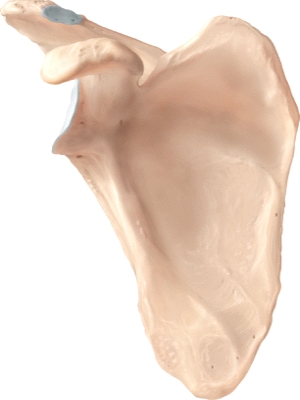


Unlock Deck
Unlock for access to all 75 flashcards in this deck.
Unlock Deck
k this deck
44
The greater tubercle of the humerus is separated from the lesser tubercle by the __________ _______.

Unlock Deck
Unlock for access to all 75 flashcards in this deck.
Unlock Deck
k this deck
45
The knuckle joints are formed by articulations between the _____ and the _____ ______.

Unlock Deck
Unlock for access to all 75 flashcards in this deck.
Unlock Deck
k this deck
46
The bone illustrated is the _____. 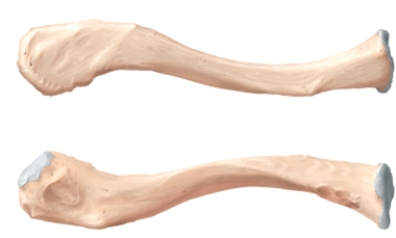


Unlock Deck
Unlock for access to all 75 flashcards in this deck.
Unlock Deck
k this deck
47
Name the articular surfaces of the hip (coxal) bones and identify the bones that articulate at each surface.

Unlock Deck
Unlock for access to all 75 flashcards in this deck.
Unlock Deck
k this deck
48
Name and describe the locations of the seven bones of the tarsus (ankle).

Unlock Deck
Unlock for access to all 75 flashcards in this deck.
Unlock Deck
k this deck
49
Give an anatomical description of the scapula, describing the features that are visible from the posterior aspect.

Unlock Deck
Unlock for access to all 75 flashcards in this deck.
Unlock Deck
k this deck
50
The _____ is the only bone of the foot to articulate with the tibia and the fibula.

Unlock Deck
Unlock for access to all 75 flashcards in this deck.
Unlock Deck
k this deck
51
List and describe the structural differences between male and female pelves.

Unlock Deck
Unlock for access to all 75 flashcards in this deck.
Unlock Deck
k this deck
52
The total number of phalanges in the body is _____.

Unlock Deck
Unlock for access to all 75 flashcards in this deck.
Unlock Deck
k this deck
53
The boundary between the false pelvis and the true pelvis is an oblique plane, the circumference of which is called the _____ ______.

Unlock Deck
Unlock for access to all 75 flashcards in this deck.
Unlock Deck
k this deck
54
The largest of the carpal bones is the _____.

Unlock Deck
Unlock for access to all 75 flashcards in this deck.
Unlock Deck
k this deck
55
The ulna and radius each bear a _____ process at their distal ends.

Unlock Deck
Unlock for access to all 75 flashcards in this deck.
Unlock Deck
k this deck
56
The distal end of the fibula forms the _____ malleolus.

Unlock Deck
Unlock for access to all 75 flashcards in this deck.
Unlock Deck
k this deck
57
Give an anatomical description of the femur as it would appear from the posterior aspect.

Unlock Deck
Unlock for access to all 75 flashcards in this deck.
Unlock Deck
k this deck
58
The fibular notch is located at the distal end of the _____.

Unlock Deck
Unlock for access to all 75 flashcards in this deck.
Unlock Deck
k this deck
59
A large depression on the _____ surface of the ilium is called the iliac fossa.

Unlock Deck
Unlock for access to all 75 flashcards in this deck.
Unlock Deck
k this deck
60
The hip (coxal) bones unite anteriorly with each other to form a joint called the _____ _______. They articulate posteriorly with the _____.

Unlock Deck
Unlock for access to all 75 flashcards in this deck.
Unlock Deck
k this deck
61
The pelvic girdle allows for a greater range of motion. The pectoral girdle offers more strength.
A) Both statements are true.
B) Both statements are false.
C) The first statement is true; the second is false.
D) The second statement is true; the first is false.
A) Both statements are true.
B) Both statements are false.
C) The first statement is true; the second is false.
D) The second statement is true; the first is false.

Unlock Deck
Unlock for access to all 75 flashcards in this deck.
Unlock Deck
k this deck
62
The fibula is a common source for bone grafting because the fibula
A) is not a weight bearing bone.
B) has more nutrient arteries compare to other bones.
C) can undergo interstitial growth throughout an individuals lifetime.
D) undergoes intramembranous ossification.
A) is not a weight bearing bone.
B) has more nutrient arteries compare to other bones.
C) can undergo interstitial growth throughout an individuals lifetime.
D) undergoes intramembranous ossification.

Unlock Deck
Unlock for access to all 75 flashcards in this deck.
Unlock Deck
k this deck
63
Abnormal elevation of the medial longitudinal arch of the foot is a sign of which condition?
A) clawfoot
B) flatfoot
A) clawfoot
B) flatfoot

Unlock Deck
Unlock for access to all 75 flashcards in this deck.
Unlock Deck
k this deck
64
The viscerocranium develops into the bones of the skull.

Unlock Deck
Unlock for access to all 75 flashcards in this deck.
Unlock Deck
k this deck
65
Which structure separates the true pelvis from the false pelvis? 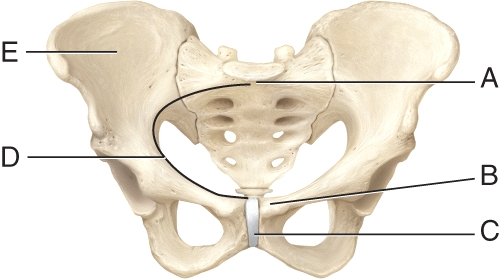
A) A
B) B
C) C
D) D
E) E

A) A
B) B
C) C
D) D
E) E

Unlock Deck
Unlock for access to all 75 flashcards in this deck.
Unlock Deck
k this deck
66
Identify the medial malleolus. 
A) A
B) B
C) C
D) D
E) E

A) A
B) B
C) C
D) D
E) E

Unlock Deck
Unlock for access to all 75 flashcards in this deck.
Unlock Deck
k this deck
67
Which pectoral girdle does not articulate with the bones of the vertebrae?
A) pectoral
B) pelvic
A) pectoral
B) pelvic

Unlock Deck
Unlock for access to all 75 flashcards in this deck.
Unlock Deck
k this deck
68
Identify the ischial tuberosity. 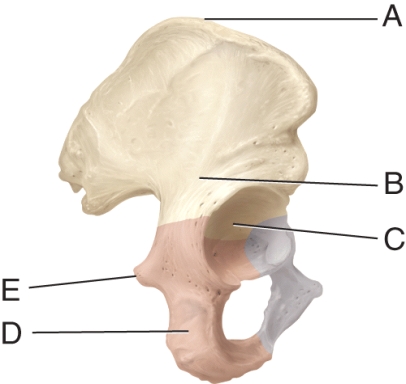
A) A
B) B
C) C
D) D
E) E

A) A
B) B
C) C
D) D
E) E

Unlock Deck
Unlock for access to all 75 flashcards in this deck.
Unlock Deck
k this deck
69
This is the _____ of the _____. 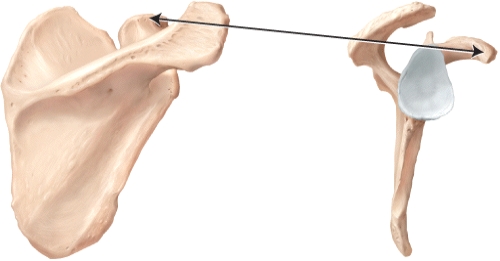


Unlock Deck
Unlock for access to all 75 flashcards in this deck.
Unlock Deck
k this deck
70
List the bones that make up the appendicular skeleton using the headings pectoral girdles, free part of the upper extremity, pelvic girdle, free part of the lower extremity.

Unlock Deck
Unlock for access to all 75 flashcards in this deck.
Unlock Deck
k this deck
71
Identify the navicular bone. 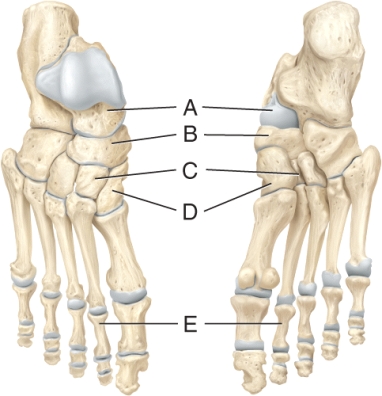
A) A
B) B
C) C
D) D
E) E

A) A
B) B
C) C
D) D
E) E

Unlock Deck
Unlock for access to all 75 flashcards in this deck.
Unlock Deck
k this deck
72
Identify the head of the radius. 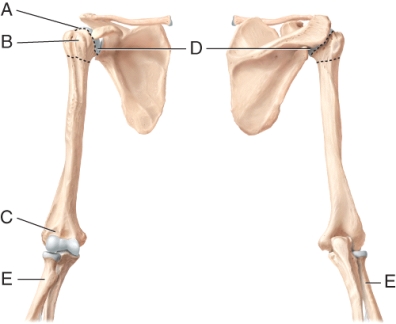
A) A
B) B
C) C
D) D
E) E

A) A
B) B
C) C
D) D
E) E

Unlock Deck
Unlock for access to all 75 flashcards in this deck.
Unlock Deck
k this deck
73
The upper limb buds develop before the lower limb buds.

Unlock Deck
Unlock for access to all 75 flashcards in this deck.
Unlock Deck
k this deck
74
The coronoid process of the ulna is medial to the head of the radius.

Unlock Deck
Unlock for access to all 75 flashcards in this deck.
Unlock Deck
k this deck
75
The linea aspera is located on the anterior side of the femur.

Unlock Deck
Unlock for access to all 75 flashcards in this deck.
Unlock Deck
k this deck



